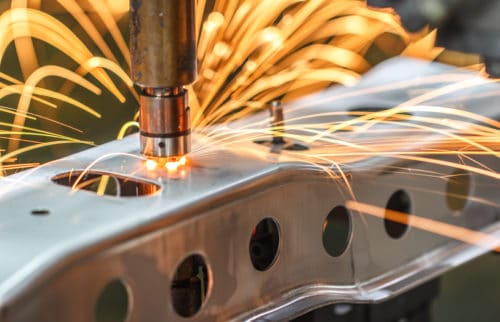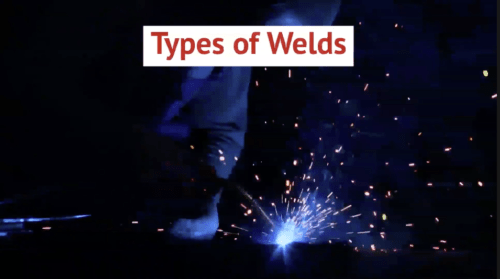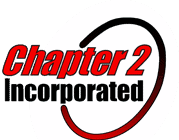Guide to Weld Types

What Is The Welding Process?
Welding is the process of joining two surfaces together by applying heat, pressure, or a combination of both. The types of welds used to create the weld joint can be categorized into various types, which are largely defined by their cross-sectional shape and the methods used to produce them. Understanding the various weld types and their distinct characteristics and advantages is the first step toward achieving a reliable, high-quality weld that meets your application-specific requirements.
Here, we cover some of the most common weld types, their key benefits, and the applications for which they are best suited. To learn more about Chapter 2’s welding capabilities, visit our capabilities page.
Fillet Welds
A fillet weld joins two surfaces perpendicularly, forming an approximate right angle between them. This style of weld can be further categorized into the following subtypes:
- Full fillet weld. With full fillet welds, the weld size is equal to the thickness of the thinner part being joined.
- Staggered intermittent fillet weld. Staggered intermittent fillet welds are characterized by the formation of two lines of offset intermittent welding on both sides of the joint.
- Chain intermittent fillet weld. Chain intermittent fillet welds involve the formation of two lines of intermittent fillet welds that are approximately opposite to one another on either side of a T joint.
The versatility and low cost of fillet welds have made them one of the most widely-used joints in the welding industry. Typical applications include:
- Connecting flanges to pipes
- Bracing connections
- Shear tabs
- Cover plates
- Column bases
- Seam and stitch welds
Groove Welds
Groove welds allow parts to be joined in the same plane by depositing welding beads in a groove between them. The basic types of groove welds include:
- Flare-bevel weld
- Flare-V weld
- Single-bevel groove weld
- Single-J groove weld
- Single-U groove weld
- Single-V groove weld
- Square groove weld
Compared with other forms of welding, the groove welding process is generally more time-consuming, harder to perform, and typically requires special beveling on one or both surfaces being joined. However, it creates an easy-to-inspect, high-strength weld and offers good distortion control. Common applications of groove welds include:
- Moment connections
- Column splices
- Hollow structural steel (HSS) connections

Surfacing Weld
Surfacing is a welding process in which the weld is applied to the surface rather than the joint to achieve certain properties or dimensions. This is accomplished by depositing one or more strings of weave beads onto an unbroken surface. The most common types of surfacing welds include:
- Flux-cored arc welding (FCAW) surfacing
- Furnace fusing
- Gas metal arc welding (GMAW) surfacing
- Gas tungsten arc welding (GTAW) surfacing
- Oxy-acetylene surface welding
- Plasma arc surfacing
- Submerged arc welding (SAW) surfacing
- Submerged metal arc welding (SMAW) surfacing
Surfacing welds are commonly used to add a wear-resistant layer of metal to an object to strengthen its surface or rebuild worn areas. In these cases, a metal with a greater wear resistance than the base metal is used to perform the welding. This technique is one of the most cost-effective methods for protecting and prolonging the life of equipment and tools used in aggressive, high-wear applications. Surface welding can also be used in conjunction with square butt joints to enhance the quality of the final weld.
Plug Weld
Plug welds are circular welds used to fasten two surfaces together through a small hole in one of the surfaces. In automotive applications, plug welds are commonly used in place of spot welds when there is insufficient space to accommodate spot welding equipment. The resulting weld is often stronger than a spot weld. Similarly, plug welds can be used to refill damaged holes in expensive aerospace components, returning them to a like-new state and saving companies on MRO costs.
Other applications include:
- Welding rods inside a pipe
- Joining metals that differ in thickness
- Auto body manufacturing and repair
Slot Weld
With slot welds, one surface is joined to another through an elongated hole. The difference between plug and slot welds is that the plug weld’s shape is characterized by its diameter, whereas the slot weld’s shape is characterized by both diameter and length. Depending on the part’s specifications, one end of the hole may be open, or the hole can be partially or completely filled with weld material.
Slot welds are beneficial when the part’s design requires an overlapping between two surfaces. Specific uses of slot welds include:
- Transmitting shear force in lap joints
- Preventing buckling in overlapped parts
Flash Weld
Flash welding is a method of resistance welding that eliminates the need for filler metals. During the flash welding process, a current is applied to create a resistance between the two surfaces to be joined. When the two surfaces come together at small contact points, the current flows and melts the material.
The melted material then exits the joint in a spray of molten particles, which creates the distinctive flashing action. Oxides and other contaminants are eliminated from the interface while a heat-softened zone is formed at the ends of the two surfaces. When enough material has melted, a force is then applied to join the surfaces. This facilitates the creation of a butt weld with no residual melted material in the joint.
The flash welding process is fast, economical, and capable of fusing dissimilar metals with different melting points. Flash welds are often used for:
- Joining sections of mainline rail in railway construction
- Connecting thick workpieces such as chains or pipes
- Merging metal sheets, rods, and bars
Seam Weld
Seam welds allow materials to be overlapped and joined along a continuous seam. This type of weld can be created using two methods:
- Resistance seam welding. Resistance seam welding is an adaptation of spot welding that uses motor-driven wheels instead of stationary rods for the welding electrodes. Common uses include sheet metal fabrication and the manufacturing of automotive components such as fuel tanks, radiators, and steel drums.
- Friction seam welding. With friction seam welding, heat is generated using friction instead of electrodes. This allows the surfaces to be merged while in the solid phase, thereby eliminating the occurrence of interdiffusion. Friction seam welding is often preferred for materials that are inherently difficult to weld using traditional arc welding methods.
Benefits of seam welding include:
- Provides sturdy, durable welds
- Relatively easy to perform
- Ideal for manufacturing liquid- and gas-tight vessels
Spot Weld
Spot welding is a form of resistance welding used to merge two or more pieces of sheet metal without the use of filler material. This is achieved by concentrating an electrical current into small, precisely-spaced spots between the adjoined surfaces. Shaped copper alloy electrodes are used to convey the electrical current through the sheet metal pieces at the predetermined locations. Once the material is melted, the current is removed and pressure is maintained while the molten material hardens to create the spot weld.
Spot welds are relatively easy and inexpensive to create, making them a popular weld choice in several key industries, including:
- Automotive
- Aerospace
- Construction
- Electronics
- Metal furniture building
- Railway
Upset Weld
Upset welding is a form of resistance welding that produces fusion concurrently across an area of adjoining surfaces, or progressively along a joint, using a combination of heat and pressure. Pressure is applied prior to and during the heating process, and heat is created by the electrical resistance occurring at the points of contact between the surfaces. Upset welds are commonly used in the fabrication of wire rings, burner rings, wheel rims, and other circular components with small cross-sectional areas.
The upset welding process delivers several distinct benefits, including:
- High-quality welds with fewer fusion defects
- Compatibility with a wide variety of standard and difficult-to-weld materials
- Welding equipment that is easy to control, operate, and maintain
Welding Services from Chapter 2, Inc.
Choosing the appropriate weld type for a given welding application is critical to the performance, reliability, and safety of the final welded component. At Chapter 2, Inc., we are an ISO 9001:2015-certified full-service manufacturer offering various welding services to meet different welding requirements. Our capabilities include MIG, TIG, aluminum, and robotic welding, allowing us to handle complex welds or difficult-to-weld materials with exceptional efficiency.
Contact us to learn more about the various weld types and how we can customize our manufacturing approach to meet your needs. To get started on your next project, request a quote today using our online form.


Comments are closed